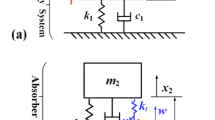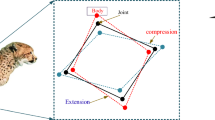Abstract
Electric and hybrid vehicle engines produce a complex spectrum of vibration and noise. Various active mounting techniques have been developed to isolate them. These are designed to continuously control the dynamic characteristics of the mounts and improve the noise, vibration, and harshness (NVH) performance under various operating conditions. Active mounts have attracted attention as replacement for existing mounts by simultaneously realizing static and dynamic stiffness, which is important for supporting an engine. Therefore, this study focuses on the vibration isolation performance of the upper plate and lower plate when the structure, including the active mounting system, is applied to multifrequency excitation. The overall modeling is based on the lumped parameter model, and the input signal is applied to the amplitude modulated and frequency modulated signals. The adaptive filter is applied for control, and the normalization least mean square (NLMS) algorithm, which is commonly used in research, is extended to a multi-NLMS algorithm. It is shown that when multifrequency input is applied, the adaptive filter is effectively applied to the active mounting system to control vibration.
Similar content being viewed by others
Abbreviations
- m s :
-
Mass of the upper plate
- m r :
-
Mass of the lower plate
- m st :
-
Mass of the actuator
- I s,y :
-
y-direction inertia about upper plate
- I r,y :
-
y-direction inertia about lower plate
- I s,x :
-
x-direction inertia about upper plate
- I r,x :
-
x-direction inertia about lower plate
- ε s :
-
Displacement of the upper plate
- ε r :
-
Displacement of the lower plate
- ε st i :
-
Displacement of each actuator
- ξ sti, g1 :
-
Displacement of the upper plate at each actuator part
- ξ sti, g2 :
-
Displacement of the lower plate at each actuator part
- θ s :
-
Rotational displacement of the upper plate
- θ r :
-
Rotational displacement of the lower plate
- θ sf :
-
Rotational displacement of the upper plate about flank
- θ rf :
-
Rotational displacement of the lower plate about flank
- w z :
-
Excitation force
- f st i :
-
Actuator force
- μ :
-
Step size (mu)
- a sti, g1 :
-
Output signal at each actuator path in the upper plate
- a sti, g2 :
-
Output signal at each actuator path in the lower plate
References
M. Hosseini, S. Arzanpour, F. Golnaraghi and A. M. Parameswaran, Solenoid actuator design and modeling with application in engine vibration isolators, Journal of Vibration and Control, 19 (7) (2012) 1015–1023.
R. Kraus, S. Herold, J. Millitzer and T. Jungblut, Development of active engine mounts based on piezo actuators, ATZ Peer Review, 116 (2014) 50–55.
M. H. Harun, M. A. Azhari, R. Yunos, A. K. M. Yamin and M. Z. Sariman, Characterization of a magnetorheological fluid damper applied to semi-active engine mounting system, 6th ECCOMAS Conference on Smart Structures and Materials, 5 (3) (2018) 2448–259.
F. Hausberg, C. Scheiblegger, P. Pfeffer, M. Plochl, S. Hecker and M. Rupp, Experimental and analytical study of secondart path variations in active engine mounts, Journal of Sound and Vibration, 340 (2015) 22–38.
H. D. Chae and S.-B. Choi, A new vibration isolation bed stage with magnetorheological dampers for ambulance vehicles, Smart Materials and Structures, 24 (2015) 0964–1726.
T. J. Yang, Z. J. Suai, Y. Sun, M. G. Zhu, Y. H. Xiao, X. G. Liu, J. T. Du, G. Y. Jin and Z. G. Liu, Active vibration isolation system for a diesel engine, Noise Control Engr. J., 60 (3) (2012) 267–282.
J. Jeon, Y.-M. Han, D.-Y. Lee and S.-B. Choi, Vibration control of the engine body of a vehicle utilizing the magnetor-heological roll mount and the piezostack right-hand mount, Journal of Automobile Engineering (2013) 1–16.
J. Jiang, W. Gao, L. Wang, Z. Teng and Y. Liu, Active vibration control based on modal controller considering structure-actuator interaction, Journal of Mechanical Science and Technology, 32 (8) (2018) 3515–3521.
V. Fakhari, S.-B. Choi and C.-H. Cho, A new robust adaptive controller for vibration control of active engine mount subjected to large uncertainties, Smart Materials and Structures, 24 (2015) 1–10.
B. Kim, G. N. Washington and R. Singh, Control of incommensurate sinusoids using enhanced adaptive filtering algorithm based on sliding mode approach, Journal of Sound and Vibration, 19 (8) (2012) 1265–1280.
B. Kim, G. N. Washington and R. Singh, Control of modulated vibration using an enhanced adaptive filtering algorithm based on model-based approach, Journal of Sound and Vibration, 331 (2012) 4101–4114.
B. Kim, G. N. Washington and H.-S. Yoon, Active vibration suppression of a 1D piezoelectric bimorph structure using model predictive sliding mode control, Smart Materials and Structures, 11 (2013) 623–635.
M. Elahinia, C. Ciocanel, The M. Nguten and S. Wang, MR- and ER based semiactive engine mounts, Smart Materials Research, 831017 (2013) 21.
W. Wu, X. Chen and Y. Shan, Analysis and experiment of a vibration isolator using a novel magnetic spring with negative stiffness, Journal of Sound and Vibration, 333 (2014) 2958–2970.
T. Q. Truong and K. K. Ahn, A new type of semi-active hydraulic engine mount using controllable area of inertia track, Journal of Sound and Vibration, 329 (2010) 247–260.
T. Kamada, T. Fujita, T. Hatayama, T. Arikabe, N. Murai, S. Aizawa and K. Tohyama, Active vibration control of frame structures with smart structures using piezoelectric actuators (vibration control by control of bending moments of columns), Smart Materials and Structures, 6 (1997) 448–456.
T. Loukil, O. Bareille, M. N. Ichchou and M. Haddar, A low power consumption control scheme: Application to a piezostack-based active mount, Frontiers of Mechanical Engimeering, 8 (2013) 383–389.
L. Sui and X. X. G. Shi, Piezoelectric actuator design and application on active vibration control, Physics Procedia, 25 (2012) 1388–1396.
S. Herold, R. Kraus, J. Millitzer and G. de Rue, Vibration control of a medium-sized vehicle by a novel active engine mount, Proc. of 4th PTPIESA Symposium (2013).
T. Bartel, S. Herold, D. Mayer and T. Melz, Development and testing of active vibration control systems with piezoelectric actuators, 6th ECCOMAS Conference on Smart Structures and Materials (2013).
J. Liette, J. T. Deryer and R. Singh, Interaction between two active structural paths for source mass motion control over mid-frequency range, Journal of Sound and Vibration, 333 (2014) 2369–2385.
Acknowledgments
This study was supported by the National Research Foundation of Korea (NRF) grant funded by the government of Korea (Ministry of Science, ICT & Future Planning) (No. 2019R1F1A1061172) as well as by the 2017 Yeungnam University Research Grant (217A380020).
Author information
Authors and Affiliations
Corresponding author
Additional information
Recommended by Associate Editor Junhong Park
Dongwoo Hong received his M.S. from the Department of Mechanical Engineering at the Yeungnam University. He is currently an Ph.D. course at the Yeungnam University. His research interests are smart structures, vibration control, and deep learning, especially in automotive NVH applications.
Byeongil Kim received his Ph.D. from the Department of Mechanical Engineering at the Ohio State University. He is currently an Assistant Professor at Yeungnam University. His research interests are smart structures and vibration control, especially in automotive NVH applications.
Rights and permissions
About this article
Cite this article
Hong, D., Kim, B. Vibration reduction against modulated excitation using multichannel NLMS algorithm for a structure with three active paths between plates. J Mech Sci Technol 33, 4673–4680 (2019). https://doi.org/10.1007/s12206-019-0910-0
Received:
Revised:
Accepted:
Published:
Issue Date:
DOI: https://doi.org/10.1007/s12206-019-0910-0




